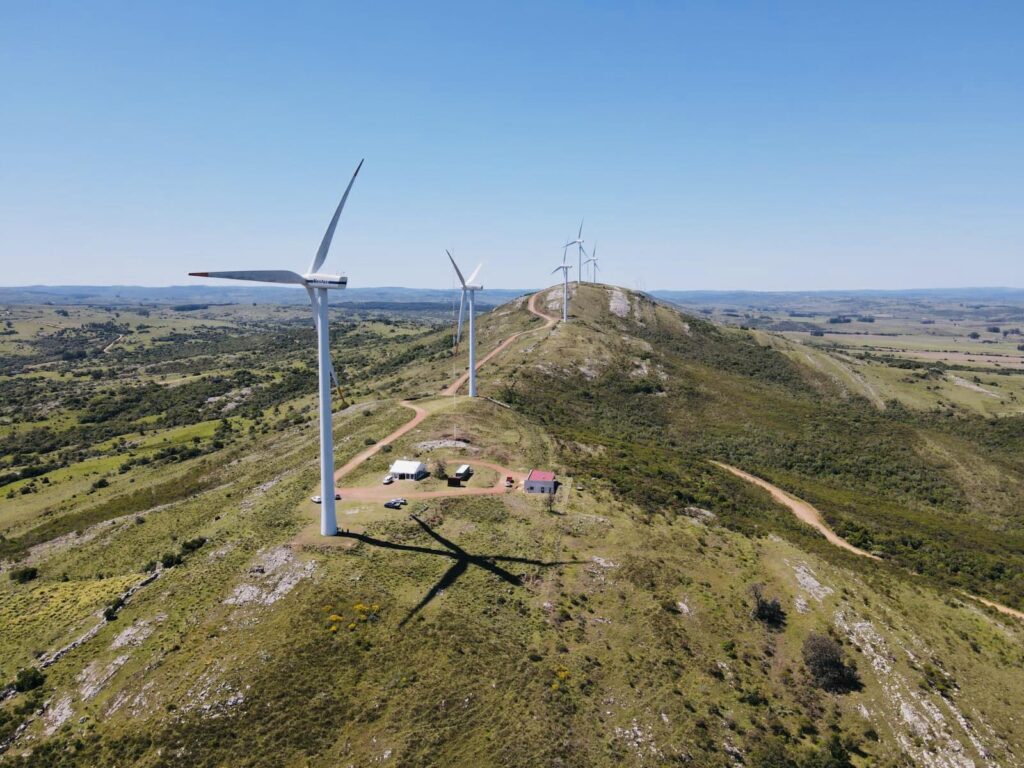

Ramón Méndez Galain, who served as Uruguay’s National Director of Energy from 2008 to 2015, under two administrations, said that in a matter of a few years, his country went from being heavily dependent on fossil fuels for electricity production to having a grid that is more than 90% renewable. Wind energy supplies up to 40% of the country’s power needs.
Electricity prices not only are much lower than they used to be, he said, but they are predictable, and the supply of energy is locked in for the long term. On top of that, the transition has created some 50,000 new jobs—representing about 3% of the country’s labor force.
“What happened in Uruguay was fundamentally the result of public policies,” Méndez said in a recent interview with the Energy and Climate Partnership of the Americas (ECPA). He said the changes required not just new infrastructure but a “transformative ecosystem” with new laws, regulations, training, institutional change, and consensus-building.
Today, Méndez heads a nonprofit organization in Montevideo and advocates for a sustainable energy transition, working with countries in Latin America and the Caribbean and beyond. His growing platform has included a TED talk and interviews with countless media outlets. In October, the University of Pennsylvania’s Kleinman Center for Energy Policy awarded him the Carnot Prize, which recognizes distinguished contributions to energy policy.

Sound public policies were the key to transforming the energy picture in Uruguay, according to Ramón Méndez, shown here accepting the Carnot Prize at the University of Pennsylvania. Credit: T. Kevin Birch
“Many have noted that the answer to our global climate crisis lies in our capacity to imagine,” University of Pennsylvania President Elizabeth McGill said in introducing the award recipient at a ceremony in Philadelphia. “Dr. Méndez’s leap of imagination and his ability to share that vision with others has resulted in one of the most striking decarbonization stories on planet Earth.”
Méndez did not set out to become an energy expert. In fact, he told the audience in Philadelphia, he was enjoying academic life as a particle physicist at a university when he decided to turn his attention to the country’s growing energy crisis.
Back then, he said, about half of Uruguay’s energy mix came from imported fossil fuels, at a cost that at times exceeded 2% of GDP. The country was also experiencing some energy shortages.
Méndez started talking to energy experts, he said, and soon came to understand the complexity of the energy situation, with all its technological, economic, geopolitical, environmental, social, cultural, and even ethical dimensions. A comprehensive proposal he developed to tackle the problem eventually reached the desk of President Tabaré Vázquez, who gave the physicist a call and invited him to implement it.
“I did something crazy,” Méndez told the audience in Philadelphia. “I accepted.”
When José Mujica was elected to succeed Vázquez, the incoming president asked Méndez to remain in office and continue the process he had started—but Mujica insisted that the policy be accepted across the political spectrum. Negotiations began with all the parties represented in parliament, and after minor changes, Méndez said, the result was “a long-term policy, backed by the entire Uruguayan political system.”
This consensus, he said, allowed the country to make rapid progress and achieve an almost completely decarbonized mix in five years.
Renewable sources—hydroelectric power, wind, biomass, and solar energy—now cover up to 98% of Uruguay’s energy needs in a normal year and still over 90% in a very dry one, according to Méndez.
The central role of wind in the country’s energy mix has demonstrated that if a system is designed correctly, it can be flexible enough to handle intermittency, he said. By balancing complementary resources in particular locations and at particular times of day, Uruguay has been able to incorporate large amounts of nontraditional renewables without any battery storage.
Getting to that point required developing a whole new system for dispatching energy, designed to maximize the use of the lowest-cost resources: wind and solar. One key component that was needed was a more precise way to predict the availability of these resources. A team led by the Universidad de la República amassed a century’s worth of rainfall data and built a sophisticated model to determine, for example, when would be the optimal time to release water from a dam or to switch on a backup natural gas-fired plant.
In the interview with ECPA, Méndez said the system is accurate enough that it can predict how much wind power will be available across the country several days into the future at a specific time of day, within a small margin of error. That means that wind and solar can be in the driver’s seat, with other resources filling in where necessary.
Currently, solar comprises only about 4% of the country’s energy mix, and Méndez said that is where he expects the most growth in the coming years.

La Jacinta, located in northern Uruguay, began operating in 2015, becoming the first large-scale solar farm in the country. Credit: FRV Future Renewable Vision.
After hydropower and wind, biomass is another important energy source, accounting for 15-20% of the electricity Uruguay produces. Wood pulp plants, for example, are now burning organic waste to produce energy for the grid, turning what was an environmental liability into an energy asset. (This is considered a carbon-neutral source of energy, Méndez explained, since what is being released into the atmosphere is the same carbon that had been stored in the organic matter.)
A system based on renewable energy required not just new technical models but a new business model too, according to Méndez. In the case of a traditional thermal energy plant that runs on fossil fuels, he said, as much as 80% of the expense is related to the cost of the fuel, which fluctuates with the spot market.
“It is absolutely different with renewable energy sources,” he added, “because the fuel is free, because the operating and maintenance cost is very low, and because the final cost of the energy is the cost of repaying the investment. And so, this is a business that is almost purely financial.”
That difference enabled the government to take a long-term perspective and enter into power purchase agreements (PPAs) with private companies, providing certainty about what it would pay for energy for years into the future.
The state-owned public utility, UTE, held auctions for projects based on its predetermined needs for each source of energy. For example, Méndez said, it might hold a bidding process for a specific amount of wind capacity; the company offering the best price would get a contract guaranteeing that the public utility would buy 100% of the electricity it produced over period of, say, 20 years. The utility would have a guaranteed supply, and the generation companies would have a guaranteed return on investment through customers’ utility bills.
Uruguay had put strict regulations in place for its new energy market, which some feared would scare away investors, Méndez said. “The opposite happened,” he added. “There was an avalanche of investments.”
While the private sector made the investment on the generation side, the public utility invested heavily in the transmission and distribution infrastructure. The public good is not a windmill or a solar panel, Méndez said, but the electricity delivered to customers.
There were some tradeoffs in transitioning to the new system, Méndez acknowledged. Prices for generating wind and solar were declining, so it might have been possible to sign power purchase agreements at lower prices by waiting. However, the government decided it was better to start saving as soon as possible, rather than worry about whether prices might fall later. When the current PPAs start to expire in 2030, he said, the next contracts may well come in at lower prices.

The Montes del Plata wood pulp mill generates enough electricity to power 200,000 households, according to the company’s website. Credit: Montes del Plata.
These days, as Executive Director of a nonprofit called the Ivy Association, Méndez is helping other countries navigate the energy transition. (The name Ivy, he said, comes from a Guaraní word that translates roughly as “the desired land,” reflecting the organization’s commitment to sustainable solutions.)
In addition to working with individual countries, the association has produced a study for the Latin American Energy Organization (OLADE) proposing a strategy for making the energy sector in Latin America and the Caribbean more renewable. The study looked at more than 20 countries in the region and identified a total of 37 barriers that need to be overcome, whether related to policies, regulations, infrastructure, technology, economic conditions, or cultural and social factors.
The transition to clean energy will not look the same in every country, but certain elements must be in place for it to happen, Méndez said.
“The first, without a doubt, is the political will,” he said. Energy transitions take longer than any single administration, he said, so it’s important to forge broad agreements and build public support by developing “national narratives.”
The good news, he added, is that today, unlike a few years ago, the case for renewable energy can be made purely on economic and energy security grounds. Méndez, who spearheaded his country’s climate change efforts from 2015 to 2016, argued that renewable energy is cheaper and can provide stability by freeing countries from fluctuations in commodity prices, which are subject to wars and other geopolitical events completely outside their control.
“The transition to renewable energy sources is not just because of a climate mandate, but because it’s the most beneficial thing for the country. It’s that simple,” he said.
Méndez believes that this transition will happen, one way or another, and said the Latin American and Caribbean countries have made progress, with a fivefold increase in the region’s wind and solar capacity in the past 20 years. But globally, he added, wind energy has grown by four or five times in just one decade, and solar has grown by 14 times in that time.
“The world is understanding much faster than our region what the path is that we have to take,” Méndez said.
 View Map
View Map